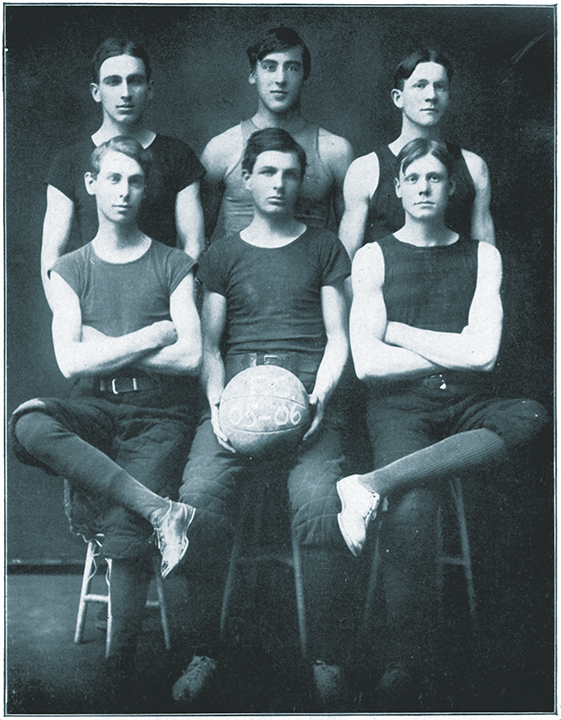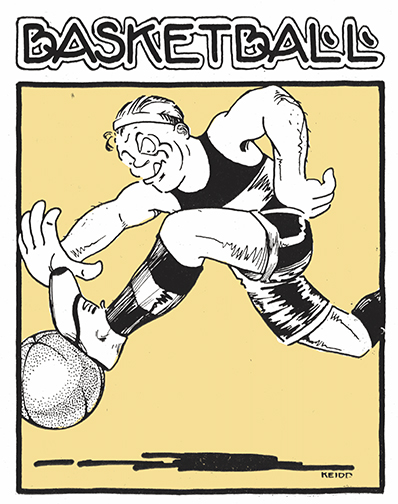
For a century now — ever since forwards Walter Martin ’09 and Claude Davis ’07, center Percy Bates ’09, guard Elmer Cooke, sub Bliss Isely ’06 and guard, team captain and manager Lawrence Abbey ’09 made, according to the 1906 Parnassus, “a good showing, winning from Hutchinson YMCA, also from Mulvane High School” — Shocker basketball has energized the Fairmount College (1895-1926), University of Wichita (1927-1964) and Wichita State (1964-present) communities with its spirit, a spirit as unique as its 100-year collective lineup of coaches and players.
As unique as its series of venues: Henrion Gymnasium, the Forum, and the Roundhouse under its various names — the Fieldhouse, Henry Levitt Arena and Charles Koch Arena.
As unique as its mascot, WuShock, who was drawn to life in 1948 by Wilber Elsea ’50 from a stylized shock of wheat.
Mirroring the times, the fashions, the evolution of the game itself, Wichita State's Shocker basketball program narrates a compelling history, complete with its own cast of heroes and anti-heroes.
While the 1906 Parnassus touts "Ten Years of Foot Ball at Fairmount” in an eight-page section, the yearbook's entry on basketball is covered in one page of text, which includes this sentence: “Although the boys' team was not organized until late in the season, they made a good showing, winning from Hutchinson YMCA, also from Mulvane High School, which team held the championship for Sumner county.”
Although the Parnassus entry doesn't actually make a note of this, those were the team's only wins that first season. Under coach Willis “Bill” Bates, who also coached Fairmount's football team, the Wheatshockers played their first official basketball game in the basement of Fairmount Hall, and lost to Washburn, 37-10.
Five seasons later, the 1911 Parnassus tells us that “Fairmount's Basketball (notice it's one word now) prestige is gradually reaching its rightful position. Our boys played against the fastest teams of the State, winning seven and losing eight games. The team was almost entirely made up of Freshmen but they played together consistently and in another year should land the State Championship.” One of Fairmount's eight losses was a home game against "K. U. College,” with the score of 23-29.
The 1911 Parnassus also shares this piece of information: “Our gymnasium is not a marvel of architectural beauty and it is quite customary for facetious visitors to point to it and ask 'what they keep in the college barn.' But that doesn't hurt our feelings at all. We're proud of our 'gym.' It is a good example of what the 'Fairmount spirit' can do. Four years ago we decided that we needed a gym. The students and faculty raised the money and built it. That's all there is to the story.
"And while it isn't the best gymnasium in Kansas, our team has frequently humbled teams which were trained in more elaborate quarters. Incidentally we would like to mention that this 'gym' has been the training quarters of the girls' basketball team which has twice won the State championship, having lost but one of the thirteen intercollegiate games played in the last two years.
"Of course we wouldn't object if some interested party would present us with a palatial gymnasium, fitted up with Brussels carpets, stained glass windowws (sic), etcetera but we don't need it very badly. We have plenty of room up here on the hill with acres of sunshine and fresh air. This combined with the Fairmount spirit helps to produce teams that fight to the finish whether winning or losing."
It wasn't until 1921 that Fairmount acquired its first permanent gym — as far as we know, sans Brussels carpets and stained glass windows. Memorial Gymnasium (renamed Henrion in 1926) opened on January 15, 1921 in a game against the American Legion of Wichita.
Fairmount College transitioned into the Municipal University of Wichita (popularly known as "WU") in 1926, and WU joined the joined the Central Conference in athletics that same year. A year later, WU earned its first regional basketball acclaim when, led by First-Team All-American Ross McBurney and Second-Team All-American Harold Reynolds, the Wheatshockers finished the 1927 season with a 13–1 record and a second-place finish behind conference champions Pittsburg State University.
Shocker basketball achieved wider acclaim with the arrival of Coach Ralph Miller and Cleophus “Cleo” Littleton in 1951. Littleton averaged 18.2 points per game as a freshman and went on to become the first player west of the Mississippi to score 2,000 points in his college career. He was also one of the first African American players in the Missouri Valley Conference, which WU had joined in 1945.
Spurred on by Shocker basketball's success, the university community determined to undertake construction of a new field house. The WU Field House — built for $1.4 million and which, for obvious reasons, came to be called simply the "Roundhouse" — opened its doors to more than 9,000 fans on Dec. 3, 1955.
Dave Stallworth entered the program in the 1961–62 season. Nicknamed "The Rave," he became the Shockers' first consensus All-American in 1964, the year WU joined the state university system as Wichita State. Wearing No. 42 for the Shockers, Stallworth led WSU to its first NCAA Tournament appearance in 1964, reaching the Midwest Fianls before losing to KSU.
The 1964–65 season was, to date, the greatest in Shocker history. On Dec. 14, 1964, Coach Gary Thompson led the Shockers to their first-ever No. 1 ranking. The 19–7 Shockers won the MVC and earned a berth into the Midwest Regional. Stallworth, who still holds nine school records, including highest career scoring average with 24.2 points per games, exhausted his eligibility before post-season play. Without Stallworth, the Shockers defeated Southern Methodist and an Oklahoma State Cowboys team led by Henry Iba — and headed to the Final Four in Portland. There, they were matched against the defending national champion UCLA Bruins, losing 108–89. The Shockers played a third-place game against Princeton, losing 118–82.
Warren Armstrong (later Jabali) was the next Shocker standout player for the Shockers. During his sophomore season, he set two school records, averaging nearly 12 rebounds a game while setting a Shocker single-game assist mark with 12. Armstrong was a three-time all-Valley performer (1966, 1967, 1968) and went on to a productive pro career. Terry Benton was a key contributor during this time, as well.
Coach Harry Miller arrived at Wichita State in 1971, leading the Shockers to a 97-90 record during his 1971-78 tenure. Among the notable players he coached were Rich Morsden, Bob Wilson, Robert Gray, Bob Trogele, Cheese Johnson, Cal Bruton and Bob Elmore.
In nine seasons as head coach of the Shockers, Gene Smithson won 155 games, placing him second in school history behind Ralph Miller. In 1981, the Shockers defeated the Kansas Jayhawks 66-65 in the NCAA tournament, in a contest dubbed the "Battle of New Orleans," before losing to LSU 96-85 in the Elite 8. The 1980-81 team featured two future NBA players: Cliff Levingston and Antoine Carr, who would be chosen in the first 10 picks of the NBA draft. Carr, a local star from Wichita, became WSU's third All-American in 1983, averaging 22.2 points a game during his senior year, and finishing his career with 1,911 points while shooting 55.7 percent. Levingston averaged 15.7 and 18.5 points per game while leading the team in scoring his freshman and sophomore years, before declaring early for the NBA Draft.
Another future NBA player, Xavier “X Man” McDaniel, entered the program the year after the Shockers reached the Elite 8. McDaniel scored 2,152 points at Wichita State, second all-time behind Littleton, and set the school record with 1,359 rebounds. In 1984-85 McDaniel became the first player in NCAA Division I history to lead the nation in scoring (27.2 points per game) and rebounding (14.8 per game) in the same season.
In 1982, Wichita State was placed under NCAA probation for the 1982-83 and 1983-84 seasons, regarding improper actions of former assistant coaches in the late 1970s. Smithson's final season with the Shockers was 1985-86, with Eddie Fogler taking up head coach duties for the 1986-87 season and coaching through 1989. Next in line were Mike Cohen (1989-92), Scott Thompson (1992-1996) and former Shocker player Randy Smithson (1996-2000).
WSU hired Mark Turgeon as head coach on March 11, 2000. Turgeon, after compiling a 9-19 record during his first season and a 15-15 record in 2001-02, steadily upped the Shockers' winning ways. Helped by an 11-3 record at home in Levitt Arena, WSU's overall record in the Roundhouse rose to 502-185 since its opening game in 1955. During the 2002-03 season, the Shockers improved to 18 wins, and then to 21 in the 2003-04 season. In 2004-05, Wichita State reached the third game of the NIT, taking the Shockers to back-to-back-to-back postseason play for the first time since 1987-88-89. WSU's 2004-05 team went 22-10 overall, finished second in the Missouri Valley Conference, and were ranked in the top 30 for nine weeks.
This past season, Turgeon led WSU to its best play in over 20 years, coaching the Shockers to their first MVC regular-season title since 1983 and reaching the Sweet 16 for the first time since 1981 with victories over 10th seeded Seton Hall and 2nd seeded Tennessee before losing to eventual Final Four participant George Mason. WSU senior Paul Miller was named MVC Player of the Year, the first Shocker since 1985 to earn the title, and only the third WSU player to garner to award since the Valley began selecting Player of the Year in 1969.
That 2006 Shocker basketball success was the perfect birthday present for the school's 100-year-old basketball program. As detailed as the story of Wichita State's program is, some information, especially from the early seasons, has been lost to time. Why, for instance, was Fairmount College playing Mulvane High in 1906? What does it actually mean for WU’s 1927 team to have been “third in nation?” And then there are those what-if questions like this one: What if Dave the Rave was eligible to play back in that 1965 dance to the Final Four?
What we do know is, whatever the date, whatever the look of the uniform, whatever the arena or its name, whomever the players on the court, that inimitable Shocker spirit was there.






